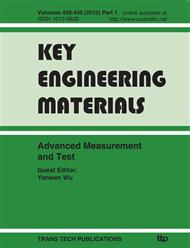[1]
Buyukozturk, O. (1998). Imaging of concrete structures., NDT&E International 31(4): 233-243.
Google Scholar
[2]
Lawrence A. Bliss Selecting Artificial Neural Network Inputs Using Particle Swarm Optimization, thesis for doctor degree, June (2003).
Google Scholar
[3]
Eberhart, R. and Kennedy, J. A New Optimizer Using Particles Swarm Theory, Proc. Sixth International Symposium on Micro Machine and Human Science (Nagoya, Japan), IEEE Service Center, Piscataway, NJ, pp.39-43. C, (1995).
DOI: 10.1109/mhs.1995.494215
Google Scholar
[4]
Eberhart, R. and Shi, Y. Comparison between Genetic Algorithms and Particle Swarm Optimization, Proceedings of the 7th International Conference on Evolutionary Programming VII, pp.611-616, (1998).
DOI: 10.1007/bfb0040812
Google Scholar
[5]
Mei Lin, W. L., Wang Yuwen (2002). A Novel Defect Evaluation Method in Infrared Based on Genetic Algorithm., ACTA OPTICA SINICA 22(12): 1452-1456. (in chinese).
Google Scholar
[6]
Favro L D, H. X., Kuo P K et al. (1995). Imaging the early time behavior reflected thermal-wave pulses., Proc. SPIE: 162-166.
Google Scholar
[7]
Favro L D, H. X., Kuo P K et al. (1996). Measuring defect depths by thermal-wave imaging., Proc. SIPE: 236-239.
Google Scholar
[8]
Vavilov V , G. E., Bison P G et al. (1996). Surface transient temperature inversion for hidden characterisation Theory and applications., Int .J. Heat Mass Transfer 39(2): 355-371.
DOI: 10.1016/0017-9310(95)00126-t
Google Scholar
[9]
X, M. (1993). Nondestructive evaluation of Materials by Infrared Thermography., London: Springer-Verlag: 1-173.
Google Scholar
[10]
Saeed Nojavan, F. -G. Y. (2006). Damage imaging of reinforced concrete structure using electromagnetic migration algorithm., International Journal of Solids and Structures 43(8): 5886-5908.
DOI: 10.1016/j.ijsolstr.2005.08.017
Google Scholar
[11]
Po-Liang Yeh, P. -L. L. (2009). Imaging of internal cracks in concrete structures using the surface rendering technique., NDT&E International 42(9): 181-187.
DOI: 10.1016/j.ndteint.2008.09.003
Google Scholar
[12]
Vavilov V , G. E., Bison P G et al. (1996). Surface transient temperature inversion for hidden characterisation Theory and applications., Int .J. Heat Mass Transfer 39(2): 355-371.
DOI: 10.1016/0017-9310(95)00126-t
Google Scholar
[13]
Chiang K-W, Noureldin A., and El-Sheimy N: A New Weights Updating Method for Neural Networks Based INS/GPS Integration Architectures;, Journal of Measurement Science and Technology, London, UK, V 15 (10), pp.2053-2061, October (2004).
DOI: 10.1088/0957-0233/15/10/015
Google Scholar
[14]
M.M. Reda Taha, A. N., N. El-Sheimy, N.G. Shrive (2003). Artificial neural networks for predicting creep with an example application to structural masonry., Canadian Journal of Civil Engineering 30(3).
DOI: 10.1139/l03-003
Google Scholar
[15]
Eberhart, R. a. K., J (1995). A New Optimizer Using Particles Swarm Theory., Proc. Sixth International Symposium on Micro Machine and Human Science (Nagoya, Japan), IEEE Service Center, Piscataway, NJ: 39-43.
DOI: 10.1109/mhs.1995.494215
Google Scholar
[16]
Shi Y, Eberhart R, A modified particle swarm optimizer [C], IEEE WorldCongress on Computational Intelligence, pp.69-73, (1998).
Google Scholar
[17]
Wang Suihua, Feng Aiqin, Li Aiguo , A BP Networks Learning Algorithm Based on PSO, Computer Engineering and Application, 13, 2003(in chinese).
Google Scholar
[18]
Chiang K-W, Noureldin A., and El-Sheimy N: A New Weights Updating Method for Neural Networks Based INS/GPS Integration Architectures;, Journal of Measurement Science and Technology, London, UK, V 15 (10), pp.2053-2061, October (2004).
DOI: 10.1088/0957-0233/15/10/015
Google Scholar


